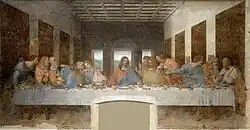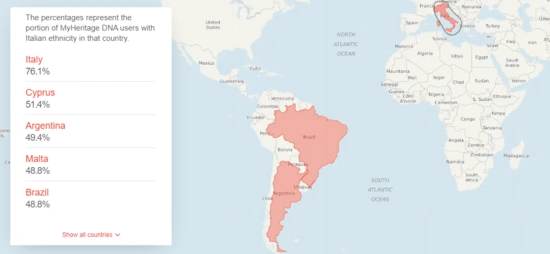
Italian ethnicity and Italians are an ethnic group inhabit modern-day Italy — ranging from the Alps in the north to the Adriatic and Tyrrhenian Seas in the south — as well as some regions of neighboring countries, such as Switzerland, France, Slovenia, and Croatia. The Italian Peninsula has historically been part of the greater northeast-Mediterranean cultural sphere, including the Etruscan, Greek, and Latin cultures. Indigenous groups, including both pre-Indo-European and Indo-European peoples, were subsumed into Latin civilization following the Roman conquest. Later incursions by Germanic tribes further expanded the genetic diversity of ethnic Italians. Over the past 500 years, Italian exploratory missions, colonies, and waves of migrations have resulted in a large Italian presence in North America and South America (U.S., Brazil, Argentina), the Middle East (Libya), Australia, and southern Africa.
Research your ancestors on MyHeritage
Italian historyItalian history

Etruscan culture in northern Italy (800 B.C.E.) and Greek culture in the south (700–600 B.C.E.) are the two main constitutive elements of the Roman culture which succeeded them. As legend has it, Rome was founded by Romulus and Remus in the heart of Etruscan Italy in 735 B.C.E. Over the next several centuries, Rome expanded its territories, and gave the peninsula its name, “Italia.” At its zenith, the Romans connected territories throughout Europe, North Africa, and the Middle East into a single cosmopolitan world empire, bound together by law, language, and the Roman road. During the 4th century C.E., Emperor Constantine established Christianity as the official religion of the Roman Empire. In 395, following a century of turmoil and divisions, the empire was split into two, a Western Empire ruled by Rome and an Eastern Empire ruled by Constantinople.
In the 5th century, Germanic tribes began pressing aggressively into the Roman provinces. In 410, the Visigoths attacked and sacked Rome, precipitating the collapse of the empire and the division of its territories into new Germanic kingdoms; in 493, the Ostrogoths conquered the Italian peninsula. The Lombards, another Germanic tribe, established a kingdom in northern Italy and 3 regions in the south. In 756, when the Franks (French) defeated the Lombards, they granted the papacy authority over central Italy, leading to the creation of the Papal States, which covered a large portion of the Italian peninsula for more than 1,000 years, until the mid-19th century. The northern regions of the peninsula were ruled by the Germanic Holy Roman Empire from 962. In the 12th century, Italian cities campaigned for autonomy, leading to the establishment of independent kingdoms, republics, and city-states in northern Italy, including Venice, Genoa, and Florence — the seat of the Italian Renaissance.

The Italian Renaissance was a cultural movement that began in Tuscany in the 14th century. Thanks to dramatic social and financial innovations, the era gave rise to a number of artistic giants, such as Leonardo Da Vinci, Michelangelo Buonarotti, and Dante Alighieri. The dominance of Tuscan culture later led the Tuscan dialect to become the official Italian language. The subsequent centuries saw Italy fall under foreign rule, including Spain, Austria, and France. Napoleon briefly united Italy, establishing the Kingdom of Italy; after the defeat of Napoleonic France in 1814, the Congress of Vienna divided Italy into 8 parts, most under foreign rule.
In 1815, resentment towards foreign domination of the peninsula motivated a movement for unification, leading to the Risorgimento, the Unification of Italy. After several failed insurrections, Italy was officially unified in 1861, with Rome and Latium annexed in 1870, and the Trieste region after the First World War. Internal political divisions and an economy devastated by World War I set the stage for the ascent of Benito Mussolini's Fascists. Under “Il Duce,” Italy invaded Ethiopia and Albania, and fought beside Nazi Germany in World War II. Mussolini was ultimately captured and executed by Italian partisans. Following the war, Italy abolished the monarchy and declared itself a republic. Today, Italy is a member of NATO, and a leading member of the European Union.
Italian ethnicity distributionItalian ethnicity distribution

People with Italian ethnicity are most commonly found in Italy, but other countries with significant portions of people with Italian ethnicity include Cyprus, Argentina, Malta, and Brazil.
Italian cultureItalian culture

Italian culture is steeped in the arts, architecture, music, food, and family. It would be hard to exaggerate the overwhelming influence Italy has had over Western culture: Roman sculpture introduced a new elaborate style built upon Greek traditions, while Renaissance masters such as Gian Lorenzo Bernini took the art form to what may be considered its highest peak in the 17th century. Italy has given rise to a number of architectural styles, including classical Roman, Renaissance, Baroque, and Neoclassical, and is home to some of the most famous structures in the world, including the Colosseum and the Leaning Tower of Pisa. Painters such as Raphael, Titian, and Caravaggio are true giants of their field. The opera, which came to be the highest form of musical theater in late-modern Europe, originated in Italy in the 16th and 17th centuries.

For many modern Italians, cuisine is one of the most important elements of their culture. Conjured from the simplest ingredients, the staples of Italian cooking typically include olive oil, garlic, balsamic vinegar, tomatoes, various kinds of pastas, and of course, cheese: parmesan, mozzarella, and ricotta are some of the more familiar varieties that have become international favorites. An authentic Italian dining experience traditionally consists of four courses: antipasti (appetizers that may include salad, soup, or a meat and cheese platter), the first course (primo piatto), the second course (secondo piatto), and dessert.
Family is an extremely important value within Italian culture. Italian family solidarity typically expands beyond the nuclear family to include the extended family as well. This value is often expressed through frequent extended family gatherings, and many Italian children are brought up to remain close to the family upon adulthood — incorporating their own families into the larger familial network.
Italian languagesItalian languages
The national language of Italy is Italian, a language descended from the Vulgar Latin of the Roman Empire. Italian, along with Sardinian, is considered to be the closest modern Romance language to its Latin ancestor. Originating in the Tuscan dialect of the Italo-Dalmatian subgroup and used by the upper class of Florentine society, Italian was adopted by the state as the national language following the Unification of Italy in the 19th century. However, regional languages, often misrepresented as dialects, persist: approximately 30 languages are spoken within the country’s borders, including Sardinian, Lombard, Piedmontese, Sicilian, Venetian, and Griko.
See alsoSee also
Explore more about ethnicity estimatesExplore more about ethnicity estimates
- MyHeritage DNA
- Ethnicities around the world at MyHeritage
- What Is My Ethnicity? How MyHeritage Estimates Ethnicities at MyHeritage Knowledge Base
- Where's My Ethnicity?!: Why An Ethnicity Might Not Show Up In Your DNA (and How To Find Evidence Of It Anyway) at MyHeritage Knowledge Base
- A Taste of Italian Heritage: Article exploring Italian heritage through cuisine from Expedia Heritage Travel Hub Bellissimo! Exploring Italian Heritage: Article on Italian heritage travel from Expedia Heritage Travel Hub

